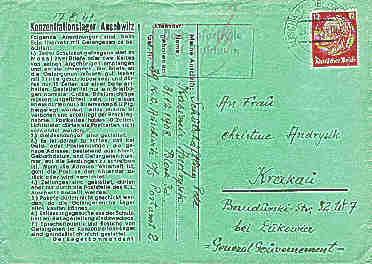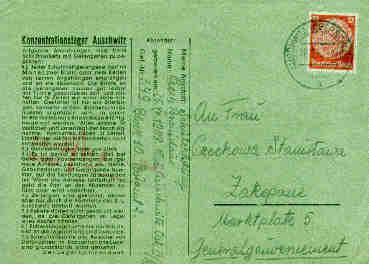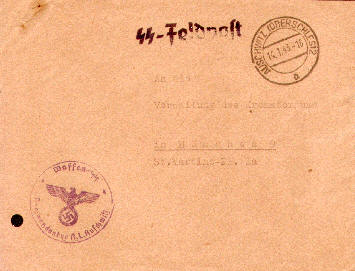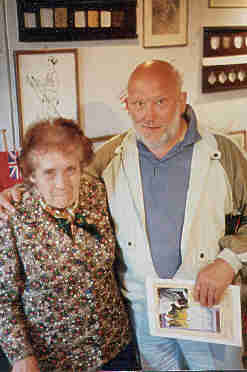
 |
| The Road to Auschwitz
As an example of how philatelic and historical research is closely related, Ian Nutley describes the results of his researches into the mail connected with Auschwitz and the Holocaust. Ian's truly amazing collection was the subject of his display entitled "The Road to Auschwitz" given to the National Philatelic Society at its Meeting held on Saturday 12 May 2000. |
| THE ECHOES OF
THEIR VOICES By Ian Nutley |
| Sometime in the early
seventies I bought a box at auction, containing a mixed lot of Third Reich
material. The very last item, in the bottom of the box, was a letter sheet from
a Polish prisoner in Auschwitz. To me this was a revelation for I did not know
at that time that Concentration Camp inmates were permitted to write at all.
This discovery set me off on a search for other, similar items, a search which has resulted in a fascination for this grim subject and a seven volume collection of the postal history of the Holocaust, including mail from every major camp and ghetto in the system. However, it is Auschwitz, situated 37 miles west of Cracow, which remains for many people as representative of the whole ghastly industry of death, as it was the largest camp of all and accounted for more lives than any other. At a conference in the office of SS General Eric von dem Bach-Zelewski in the police building in Wroclaw, early in 1940, plans for a new concentration camp were laid. The choice of site fell upon a small town in Polish Silesia, Oswiecim, which the Germans called Auschwitz. On 27 April, Inspector of Concentration Camps, SS Gruppen-führer Richard Glücks appointed SS Sturmbannführer Rudolf Höss as Kommandant. |
| On 20 May, SS NCO
Gerhard Palitzsch brought 30 Germans from Sachsenhausen Concentration Camp,
almost all of them criminals. These first "trusties" were allocated
numbers from 1 to 30. In charge of them was No 1, Bruno Brodniewicz, who became
Auschwitz's senior prisoner. Prisoner No. 30, Leon Wieczorek, was appointed
Rapportführer, responsible for discipline. The first transport of Polish, non-Jewish prisoners arrived by train from Tarnow gaol on 14 June 1940, 728 altogether, who were given numbers 31 to 758. On the same day, Paris fell to the advancing German Army. From the start these prisoners were allowed to Correspond with their families on pre-printed camp stationery, envelopes, letter sheets, letter forms and postcards. Illustrated is a cover from one of this very first batch of prisoners, No. 89, Kasimir Andrysik, who had the distinction of escaping from Auschwitz in 1944, and also survived the war. The letter is to his wife. |
 Fig. 1 A cover from Auschwitz written by Kasimir Andrysik, a Polish political prisoner who was in the very first batch of prisoners taken to the camp. His prison number was 89, and this is surely one of the lowest number covers in private hands. Andrysik escaped from Auschwitz and survived the war. |
| The rules and regulations on the
left of the cover translate as: Concentration Camp Auschwitz Following orders regarding correspondence to be noted by prisoners: 1) Each detainee can receive two letters or two cards each month from his relatives and send the same to them. The letters to the prisoners must be legibly written in ink and can consist of 15 lines on a page. Only pages of normal size are allowed. Envelopes must be unsealed. In each letter only 5 postage stamps of 12 Pfg. can be enclosed. Everything else is forbidden and liable to confiscation. Postcards have 10 lines. Photo-graphs cannot he used as postcards. 2) Money may be sent. 3) Money or other correspondence must bear the correct address: name, date of birth and prisoner number must be written on the correspondence. If the address is incorrect, the post will be returned to sender or will be destroyed. 4) Newspapers are allowed, but can only he collected at the Postal Section of Auschwitz Concentration Camp. 5) Parcels will not be allowed, as the prisoners can buy everything in the camp. 6) Requests to the Camp Authorities for discharge from Protective Custody are useless. 7) Conversations and visits with prisoners in the Concentration Camp are not allowed on principle. |
| The Camp Commandant. |
| These rules were basically the same
for all camps. Fig. 2 A cover from one of the first batch of prisoners, Bronislaus Czech, a Polish Olympic skier, arrested in 1940 and allocated prisoner No. 349. He died in Auschwitz in 1944. |
 |
| In March 1941 Heinrich Himmler ordered the construction of a second camp, much larger, to be known as Birkenau, Auschwitz II. This was the site of the gas chambers and crematoria, and in consequence most of the killing. It is estimated that at least 1,600,000 people were murdered here, the first victims of mass-murder being Jews from Silesia. A women's section was established in March 1942 and postcards headed F.K.L. Auschwitz exist but are scarce. |
 |
As a general rule Jewish and Russian
prisoners were not allowed mail privileges. Later, a group of industrial
complexes known collectively as Auschwitz III were created . Mail on standard
Auschwitz stationery but postmarked Jaworzno or Schweintochlowitz emanate from
slave workers in these factories and mines. It is also possible to find mail
into Auschwitz addressed to prisoners, and Official SS Mail from the camp, but
these are much scarcer than prisoners' post. Fig.3 An SS Fieldpost cover from the Kommandantur of Auschwitz, 1943. It is addressed to National Administration of Crematoria in Munich. |
| Soldiers of the Red Army overran Auschwitz on 27 January 1945, and found less than 8,000 sick and exhausted prisoners still alive. Survivors and victims alike must never be forgotten. "Si l'echo de leurs voix faiblit, nous périrons" (trans: "If the echo of their voices becomes faint, we will perish"). |
 |
Any collector requiring further
details on the collection of Holocaust mail should contact the author at
nps@ukphilately.org.uk Fig. 4 The author with Bronislaus Czech's sister Janina, at the Czech Museum, in Zakopane in 1994. At that time she was aged 80. Ian Nutley is a Council member of the National Philatelic Society and also of the Germany and Colonies Philatelic Society. He is a Past President of the Kent Federation of Philatelic Societies and a member of five Philatelic Societies in Kent and Surrey. He undertakes some 25/30 displays a year in both the UK and Overseas. |
| Last updated: 15th July 2001 |
| [TO RETURN TO UK HOME PAGE] | [TO RETURN TO NPS HOME PAGE] | [Disclaimer] |